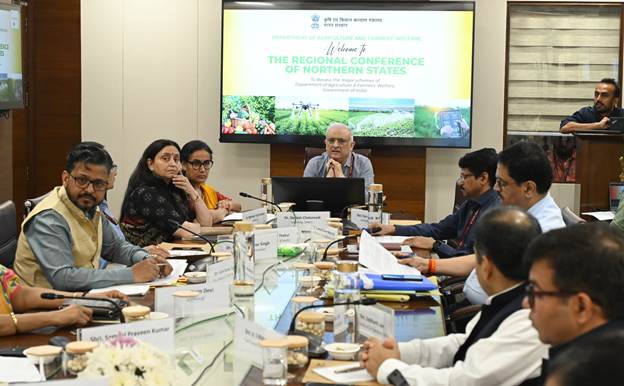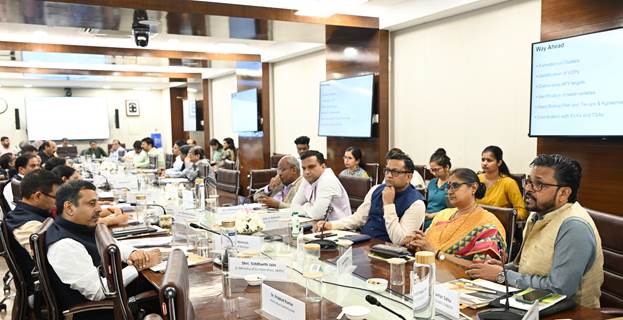Retention allowances paid to seasonal workers is to be included for PF contributions under the EPF Act, 1952 – Bombay HC
Blog
Top Stories
Retention allowances paid to seasonal workers is to be included for PF contributions under the EPF Act, 1952 – Bombay HC
Retention allowances paid to seasonal workers must be included in basic wages for PF contributions under the EPF Act, 1952.
Copy of judgement attached
Appellate authority under POSH Act has implied power to consider passing of interim order of stay as well -Karnataka HC
Appellate authority under POSH Act has implied power to consider passing of interim order of stay as well -Karnataka HC
Appellate authority under POSH Act has implied power to consider passing of interim order of stay as well –
Copy of judgement attached.
Compassionate appointment is not a vested right – Supreme Court
Compassionate appointment is not a vested right
Compassionate appointment is not a vested right.
Copy of judgement attached
Article 14 of the Constitution cannot be used to perpetuate illegality – Supreme Court
Article 14 of the Constitution cannot be used to perpetuate illegality – Supreme Court
Article 14 of the Constitution cannot be used to perpetuate illegality
Copy of judgement attached
Invitation for Bids (IFB) – Ministry of Defence
Invitation for Bids (IFB) – Ministry of Defence
Capital Overhaul & Life Extension for MI-171 Helicopter of the Sri Lanka Air Force
I wish to inform you that, the Chairman, Standing Cabinet Appointed Procurement Committee (SCAPC), Ministry of Defence, Sri Lanka, has invited sealed bids from eligible and qualified bidders in Sri Lanka or abroad for the Capital Overhaul & Life Extension for MI-171 Helicopter of the Sri Lankan Air Force as follows;
| No. | Procurement Identification No. | Description | Date and Time of Bid closing/ opening |
| 01 | AHQ/ 21/ FR/M 17/ 1012 | Capital Overhaul and Service Life Extension of SMH-595 (S/No: 59489611073) MI-171 Helicopter of the Sri Lanka Air Force | 18th November 2024 at 1000 hrs |
| 02 | AHQ/ 20/ FR/M 17/ 1005 | Capital overhaul of SMH 4415 (S/No: 171S00144115907U) MI-171 Helicopter of the Sri Lanka Air Force. | 18th November 2024 at 1430 hrs |
| 03 | AHQ/ 21/ FR/M 17/ 1013 | Capital overhaul and Service Life extension of SMH-598 (S/No. 59489611103) MI-171 Helicopter of the Sri Lanka Air Force | 18th November 2024 at 1000 hrs |
| 04 | AHQ/ 21/ FR/M 17/ 1015 | Capital overhaul of SMH 4422 (S/No: 171E00144116004U) MI-171 Helicopter of the Sri Lanka Air Force | 18th November 2024 at 1430 hrs |
| 05 | AHQ/ 21/ FR/M 17/ 1016 | Capital overhaul of SMH 4425 (S/No: 171E00144116006U) MI-171 Helicopter of the Sri Lanka Air Force. | 18th November 2024 at 1000 hrs |
Please find attached herewith a copy of the procurement notice of the above.
It would be appreciated, if you could kindly make necessary arrangements to disseminate the same among your membership.
Thank you.
With warm regards,
Shirani Ariyarathne
Actg. Consul General
Minister (Commercial)
Consulate General of Sri Lanka
34, Homi Mody Street, Fort
Mumbai 400001
Tel: (+ 91 22 )22045861/22048303
Fax: (+ 91 22) 22876132
E -mail: slcg.mumbai@mfa.gov.lk
Procurement Notice – State Pharmaceuticals Corporation of Sri Lanka
Procurement Notice – State Pharmaceuticals Corporation of Sri Lanka
I wish to inform you that, the Chairman, Departmental Procurement Committee of the State Pharmaceuticals Corporation has invited sealed bids for supply of following items to the Ministry of Health for year 2024.
| Bid Number | Closing Date & Time | Item Description | Non – refundable Bid Fee |
| DHS/SS/WW/138/22 | 20.11.2024 @09.00 a.m. | Scalpel handle, Micro vascular vessel dilator | 3,000/-+Tax |
| DHS/SS/WW/154/24 | 20.11.2024 @09.00 a.m. | Cerclage wire soft tissue | 3,000/-+Tax |
| DHS/SS/WW/118/25 | 20.11.2024 @09.00 a.m. | Cardiology Consumables | 12,500/-+Tax |
| DHS/SS/WW/119/25 | 20.11.2024 @09.00 a.m. | Coronary guiding catheter | 12,500/-+Tax |
| DHS/SS/WW/120/25 | 20.11.2024 @09.00 a.m. | Guidewires | 12,500/-+Tax |
| DHS/SS/WW/121/25 | 20.11.2024 @09.00 a.m. | Cardiology Consumables | 3,000/-+Tax |
| DHS/SS/WW/122/25 | 20.11.2024 @09.00 a.m. | Ablation catheters | 3,000/-+Tax |
| DHS/SS/WW/123/25 | 20.11.2024 @09.00 a.m. | Compatible connecting cable for ablation catheters | 3,000/-+Tax |
Please find attached herewith a copy of the procurement notice of the above.
It would be appreciated, if you could kindly make necessary arrangements to disseminate the same among your membership.
Thank you.
With warm regards,
Shirani Ariyarathne
Actg. Consul General
Minister (Commercial)
Consulate General of Sri Lanka
34, Homi Mody Street, Fort
Mumbai 400001
Tel: (+ 91 22 )22045861/22048303
Fax: (+ 91 22) 22876132
E -mail: slcg.mumbai@mfa.gov.lk
Procurement Notice–State Pharmaceuticals Corporation of Sri Lanka Bid Nos. DHS/SS/WW/24/23, DHS/SS/WW/127/55 & DHS/SS/WW/155/24 to DHS/SS/WW/158/24
Procurement Notice–State Pharmaceuticals Corporation of Sri Lanka
Bid Nos. DHS/SS/WW/24/23, DHS/SS/WW/127/55 & DHS/SS/WW/155/24 to DHS/SS/WW/158/24
I wish to inform you that, the State Pharmaceuticals Corporation of Sri Lanka has invited sealed bids for supply of surgical items to the Ministry of Health.
Closing date for the submission of the above procurements are on 22nd November, 2024 at 09:00 hrs (Sri Lanka local time GMT+ 5:30).
Please find attached herewith a copy of the procurement notices of the above.
It would be appreciated, if you could kindly make necessary arrangements to disseminate the same among your membership.
Thank you.
With warm regards,
Shirani Ariyarathne
Actg. Consul General
Minister (Commercial)
Consulate General of Sri Lanka
34, Homi Mody Street, Fort
Mumbai 400001
Tel: (+ 91 22 )22045861/22048303
Fax: (+ 91 22) 22876132
E -mail: slcg.mumbai@mfa.gov.lk
Invitation for Bids (IFB) – Ministry of Defence
Invitation for Bids (IFB) – Ministry of Defence
Invitation for Bids (IFB) – Ministry of Defence
Purchase of Spares to Recovery of Bell 212 Helicopters for the Sri Lanka Air Force
I wish to inform you that, the Chairman, Standing Cabinet Appointed Procurement Committee (SCAPC), Ministry of Defence, Sri Lanka, has invited sealed bids from eligible and qualified bidders in Sri Lanka or abroad for the Purchase of Spares to Recovery of Bell 212 Helicopters for the Sri Lankan Air Force as follows;
| No. | Procurement Identification No. | Description | Date and Time of Bid closing/ opening |
| 01 | AHQ/24/ FS/-BELL/ 1031 | Purchase of Spares to Recovery of SUH – 565 Bell 212 Helicopter for the Sri Lanka Air Force | 03rd December 2024 at 1030 hrs |
| 02 | AHQ/24/ FS/-BELL/ 1032 | Purchase of Spares to Recovery of SUH – 563 Bell 212 Helicopter for the Sri Lanka Air Force. | 03rd December 2024 at 1100 hrs |
Please find attached herewith a copy of the procurement notice of the above.
It would be appreciated, if you could kindly make necessary arrangements to disseminate the same among your membership.
Thank you.
With warm regards,
Shirani Ariyarathne
Actg. Consul General
Minister (Commercial)
Consulate General of Sri Lanka
34, Homi Mody Street, Fort
Mumbai 400001
Tel: (+ 91 22 )22045861/22048303
Fax: (+ 91 22) 22876132
E -mail: slcg.mumbai@mfa.gov.lk
Ministry of Agriculture Conducts Midterm Review of Agricultural Scheme Implementation in Northern States
Ministry of Agriculture Conducts Midterm Review of Agricultural Scheme Implementation in Northern States
The Ministry of Agriculture and Farmers Welfare held a regional conference on November today, at Krishi Bhawan, New Delhi, to conduct a midterm review of agricultural schemes implemented by Northern States. Key officials from Punjab, Uttarakhand, Himachal Pradesh, Haryana, and the Union Territories of Jammu & Kashmir, Ladakh, and Delhi gathered to evaluate progress and address challenges in the effective implementation of these schemes.
During the meeting, Secretary Dr. Devesh Chaturvedi urged states to expedite the execution of Centrally Sponsored Schemes (CSS) by ensuring timely fund allocation and addressing issues related to state contributions and Single Nodal Account (SNA) balances. He emphasized the importance of operationalizing SNA-SPARSH, returning unutilized balances and interest, and promptly submitting Utilization Certificates (UCs).
The conference focused on improving implementation of major schemes, including Rashtriya Krishi Vikas Yojana (RKVY) and Krishonnati Yojana, where non-performing states were encouraged to enhance their efforts in the remaining months of the fiscal year. Dr. Chaturvedi also advised states to finalize the RKVY annual action plan for FY 2025-26 by December to enable timely release of the first installment by April, aiming to reduce previous delays in fund utilization.

A comprehensive review of key initiatives took place, covering the Kisan Credit Card (KCC) Mission for enhancing credit access, the Pradhan Mantri Fasal Bima Yojana (PMFBY) for risk mitigation and expanded crop insurance, and the Digital Agriculture Mission for advancing data-driven agriculture. The conference highlighted the need for digital integration in crop surveys and the alignment of state land records with the Agristack to streamline operations under PM KISAN.
The meeting also discussed high-priority topics, including the National Edible Oils Mission, NABL accreditation for laboratories under the Insecticides Act, and the efficient use of the Krishi Nivesh Portal and Agricultural Infrastructure Fund (AIF) to foster sector growth.
Shri Ajeet Kumar Sahu, Joint Secretary (IC, Oilseeds & Credit), set the agenda for the review and welcomed delegates from the agriculture departments of Northern States, as well as representatives from allied departments including Tribal Affairs, NABARD, and Cooperation.
An Open House session concluded the conference, allowing stakeholders to provide insights on overcoming implementation barriers and maximizing the reach of agricultural programs. This regional conference is part of a series by the Government of India, addressing specific regional agricultural needs and aiming for equitable and sustainable agricultural development across the country.

Attending the conference were senior officials from the Department of Agriculture and Farmers Welfare, including Additional Secretaries Ms. Manindar Kaur, Dr. Pramod Kumar Meherda, Mr. Faiz Ahmed Kidwai, Ms. Shubha Thakur, and Joint Secretaries Mr. Praveen Kumar Singh, Mr. Samuel Praveen Kumar, Ms. Perin Devi, Mr. Muktanand Agrawal, Mr. Prabhat Kumar, Mr. Binod Kumar, Mr. Priya Ranjan, and Mr. Purna Chandra Kishan, as well as representatives from the Ministry of Cooperation, NABARD, and the Department of Financial Services.
This initiative reflects the government’s commitment to enhancing agricultural infrastructure, fostering growth, and supporting farmers across all regions, ensuring that each state’s unique challenges and opportunities are addressed through collaborative, targeted efforts.
Shri Piyush Goyal recently Inaugurated EEPC India’s 70th Anniversary, Urges Boost in Engineering Exports
Shri Piyush Goyal recently Inaugurated EEPC India’s 70th Anniversary, Urges Boost in Engineering Exports
Union Minister of Commerce and Industry, Shri Piyush Goyal, recently launched the 70th-anniversary celebrations of EEPC India, unveiling the new EEPC India logo in the capital. During his keynote address, Shri Goyal highlighted the Government’s initiatives aimed at reducing compliance burdens and decriminalizing laws to foster Ease of Doing Business. The event was graced by the presence of Minister of State for Commerce & Industry, Shri Jitin Prasada.
In his address, Shri Goyal underscored the importance of transforming India into a powerhouse of engineering exports, in line with the nation’s aspirations towards the Viksit Bharat goal. He urged the engineering sector to contribute actively towards resilient supply chains, high-quality production, and sustainable development, marking a critical step towards achieving the vision of a developed India.
A Model for Export Promotion
Calling EEPC India a model export promotion council, Shri Goyal commended the organization for its substantial contributions across various engineering sectors, including mobility, capital goods, and steel. He acknowledged the Council’s ambitious target of achieving $300 billion in engineering exports within the next 5-6 years, emphasizing that this vision reflects New India’s confidence and determination on the global stage.
Quoting Prime Minister Shri Narendra Modi’s mantra of “Zero Defect, Zero Effect,” the Minister reiterated the importance of quality and sustainability. He stated that India’s journey towards Viksit Bharat would be defined by high standards, enhanced productivity, and cost competitiveness. “We aim to be second to none in our ambition, mission, and vision,” Shri Goyal remarked.
Commitment to Global Standards and Innovation
Addressing the gathering, EEPC India Chairman, Shri Arun Kumar Garodia, affirmed the Council’s commitment to driving engineering exports, expanding the sector’s global footprint, and advocating for policies that support exporters. He highlighted the Ministry’s key initiatives, such as Bharat Mobility, the International Engineering Sourcing Show (IESS), Indian Engineering Exhibitions (INDEE), Export Excellence Awards, Quality Awards, Green Awards, and India Pavilions. These efforts, he noted, reflect the government’s focus on innovation and sustainability, ensuring Indian engineering products meet global standards and remain competitive.
Shri Garodia also highlighted EEPC India’s significant milestones over the past seven decades, including its instrumental role in advancing the Make in India initiative across sectors like automotive, electronics, and medical devices. He noted that EEPC India’s membership had grown from just 40 members in 1955 to over 9,500 members in 2024, showcasing the Council’s pivotal role in the growth of India’s engineering exports, which reached $109 billion in FY24.


It is a long established fact that a reader will be distracted by the readable content of a page when lookin







